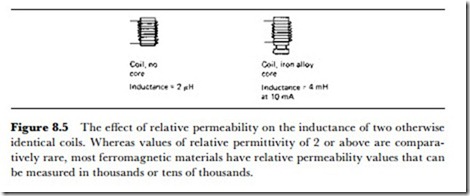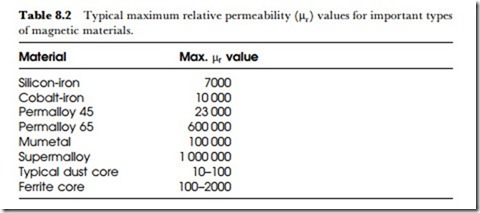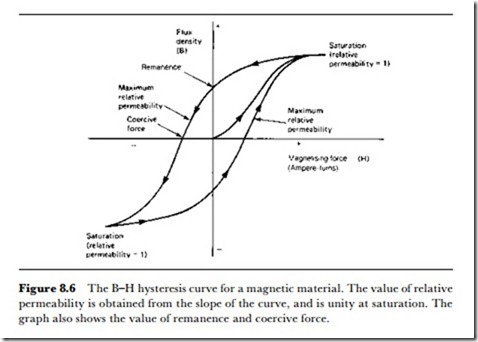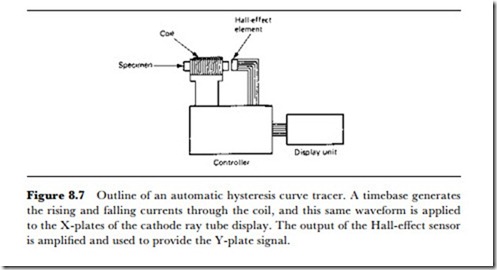Permeability and magnetic measurements
Permeability is analogous to permittivity, and its effect on the inductance of a coil is illustrated in Figure 8.5. The important difference, however, between these types of quantities is that permeability and relative permeability are not constants for a given material. We can quote a single figure of relative permittivity for a sample of mica, but for a sample of steel the
value of relative permeability is not a constant, although the maximum possible value may be fairly constant. Relative permeability values depend on the previous history of the material, in the sense that if the material has been in a magnetic field, then its value of relative permeability will be affected by the fact that it has been magnetized (see Table 8.2).
Therefore, rather than quote a single figure to describe the behaviour of a material in a magnetic field, we have to quote a number of figures, and these are illustrated in Figure 8.6 with reference to the magnetic hysteresis curve of a material. The graph shows the magnetic flux density (B) in the material plotted against the ampere-turns of magnetizing force in a coil sur-
rounding the material. We assume that the material starts unmagnetized, so that with no magnetizing force applied, there is no flux density. As the material is magnetized, then, the flux density value rises in a non-linear way.
At some value of magnetizing force the flux density reaches a peak and will from that point show very little increase, increasing only at the rate of increase of the magnetizing force itself. The peak value of flux density is called the saturation flux, and it determines how effective a material can be when used as the core of an electromagnet. If from this point the current through the magnetizing coil is reduced, the graph does not follow the same path. When the magnetizing force is zero, the flux density in the magnetic material will have some value called the remanence, or remanent flux density. A high remanence is a necessary quantity for materials intended as permanent magnets, but is highly undesirable for cores of elec- tromagnets. If the current through the magnetizing coil is now reversed and increased, a point will be reached when the flux density in the sample of material is zero. The amount of magnetizing force needed to achieve this is called the coercive force, and a high value of coercive force means that a material will be difficult to demagnetize, a desirable feature of, for example, material used for recording tape.
The use of Hall-effect sensors allows flux density to be measured even for small samples of material, so that evaluation of these magnetic quantities is much easier now than it was previously. The type of set-up illustrated in Figure 8.7 can be used to display a hysteresis curve on an oscilloscope, and the same technique of cycling the material from one saturation level to the other and back can be used to allow digital presentation. A completely automated system is microprocessor controlled, and can be made auto- ranging to allow for the enormous differences between different magnetic materials.



